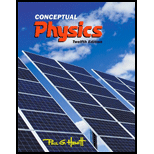
What class of motion, natural or violent, did Aristotle attribute to motion of the Moon?
The class of motion attributed to the Moon by Aristotle.
Answer to Problem 1RCQ
Solution: Natural Motion.
Explanation of Solution
According to Aristotle, if the motion of an object requires a force to make it move, it as an unnatural motion. On the other hand, if an object faces motion without being forced, it is classified as a natural motion.
Aristotle divided motion into two types:
- Natural Motion: Under this motion, the natural position of an object is at rest. The object is attracted to the center of the earth. The heavier the object is, the stronger will be the force. In this kind of motion, there are two forces, they are an upward and downward force. For example, a stone falling on the ground.
- Violent motion: Under this motion, the motion is imposed on the object. This means that an external push or pull force is applied fall in this category. For example, horse pulling a cart.
According to Aristotle, the Moon and stars − are embedded in perfectly concentric Crystal sphere" that rotate eternally at fixed rates, so the motion of the Moon come under the category of natural motion.
Conclusion:
The class of motion attributed to Moon by Aristotle was Natural motion.
Want to see more full solutions like this?
Chapter 2 Solutions
Conceptual Physics (12th Edition)
Additional Science Textbook Solutions
University Physics with Modern Physics (14th Edition)
Applied Physics (11th Edition)
The Cosmic Perspective (8th Edition)
College Physics: A Strategic Approach (4th Edition)
Conceptual Integrated Science
- Which of Keplers or Newtons laws best describes Aristotelean violent motions?arrow_forwardIn what ways did the work of Copernicus and Galileo differ from the views of the ancient Greeks and of their contemporaries?arrow_forwardBy what factor would a person’s weight be increased if Earth had 10 times its present mass, but the same volume?arrow_forward
- What are two ways in which Aristotle deduced that Earth is spherical?arrow_forwardUse a history book, an encyclopedia, or the internet to find out what else was happening in England during Newton’s lifetime and discuss what trends of the time might have contributed to his accomplishments and the rapid acceptance of his work.arrow_forwardI need the answer to question 7arrow_forward
 Foundations of Astronomy (MindTap Course List)PhysicsISBN:9781337399920Author:Michael A. Seeds, Dana BackmanPublisher:Cengage Learning
Foundations of Astronomy (MindTap Course List)PhysicsISBN:9781337399920Author:Michael A. Seeds, Dana BackmanPublisher:Cengage Learning
 Stars and Galaxies (MindTap Course List)PhysicsISBN:9781337399944Author:Michael A. SeedsPublisher:Cengage Learning
Stars and Galaxies (MindTap Course List)PhysicsISBN:9781337399944Author:Michael A. SeedsPublisher:Cengage Learning Glencoe Physics: Principles and Problems, Student...PhysicsISBN:9780078807213Author:Paul W. ZitzewitzPublisher:Glencoe/McGraw-Hill
Glencoe Physics: Principles and Problems, Student...PhysicsISBN:9780078807213Author:Paul W. ZitzewitzPublisher:Glencoe/McGraw-Hill AstronomyPhysicsISBN:9781938168284Author:Andrew Fraknoi; David Morrison; Sidney C. WolffPublisher:OpenStax
AstronomyPhysicsISBN:9781938168284Author:Andrew Fraknoi; David Morrison; Sidney C. WolffPublisher:OpenStax




